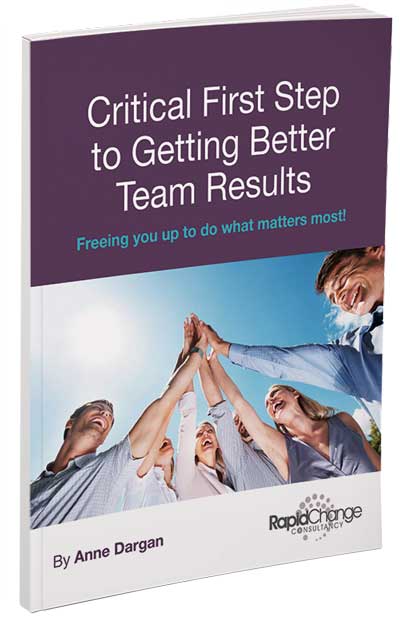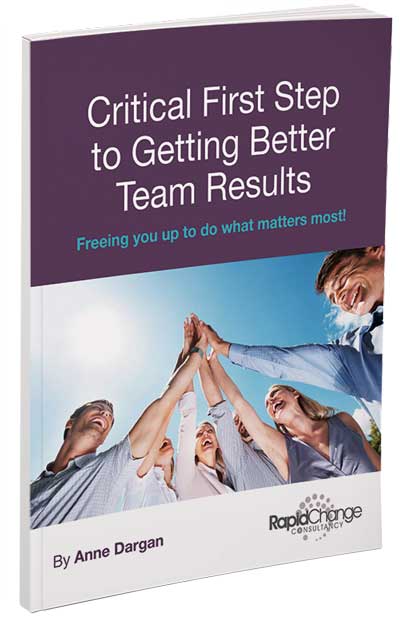Critical First Step to Getting Better Team Results
 Wednesday, September 19, 2018 at 7:42PM
Wednesday, September 19, 2018 at 7:42PM 
Do you struggle when it comes to getting the best results from your team, whether the team is underperforming or the team is already performing well but you want them to step up to new opportunities?
The thing is, it really doesn’t have to be this way. And it is much easier than you think. After reading this you will know the ONE thing to do to turn things around, leaving you free to attend to matters which are more important to you whether that be the next big challenge or more time away from work.
I know what works and what doesn’t and this is for sure the first thing to put into practice that will yield results rightaway.
I even show you when and how to apply it. Enjoy!
1. ASK, don’t TELL!
The ONE thing is: ASK, don’t TELL.
It’s as simple as that. Now if you are impatient for results, you probably think the quickest and most expedient thing is to tell your people what to do and how to do it.
The problem is when you tell someone what to do it creates immediate resistance.
In fact the latest in neuroscience tells us that the brain behaves like a two year old when it’s told what to do and automatically pushes back. If you do this repeatedly not only do you get push back, but the person on the receiving end doesn’t have to do any thinking for themselves. And you have to keep telling them. A vicious circle! Any wonder you are frustrated and exhausted. You are thinking you are helping and in actual fact you are making matters worse.
Asking, rather than telling them what to do is the secret to getting people to step up and think for themselves.
When they solve a problem for themselves, or come up with a new insight - that ‘aha’ moment - the brain gives them a chemical hit that makes them feel great - so they are more likely to buy in and take action.
Not only does it feel great, but the new connections that are created in the brain in that moment actually help to overcome the brain’s natural resistance to change. So to get the best out of your people and empower them to handle inevitable issues that arise in the work, just ASK more than TELL.
So what do I mean by ASK?
 Well, I don’t mean to substitute an instruction like “Please respond to the customer by saying…” with “Will you please respond to the customer by saying…?”. That is just rewording an instruction and making it look like a question.
Well, I don’t mean to substitute an instruction like “Please respond to the customer by saying…” with “Will you please respond to the customer by saying…?”. That is just rewording an instruction and making it look like a question.
You must ask a question that makes them think and learn, to create those connections in the brain. Ask questions which helps them to think through what outcome they want, what options they have, what they already have at their disposal that will help them, what action they will take and what they learned in the process.
This is by far and away the ONE single thing that you can do right now that will have others take more responsibility, develop their in-built desire to develop and learn, and ultimately share the load freeing you up to do other more important things.
But I know you need more than that so…
2. What does good questioning look like?
Funnily enough the way you ask a question can create even more resistance. So here are few tips on what to avoid.
Avoid questions that begin with ”Why”.
Although sometimes it’s important to understand causes and sources, questions beginning with “Why” tend to provoke justification, defence, or blame. “Why did you do it that way” implies that you don’t approve, that there was something wrong with their approach Instead of creating learning the person becomes more entrenched.
Avoid long questions.
Questions get long when you have an opinion about what is going. Here’s how it works: You have opinion, but you have just learned that you’re supposed to be asking questions, so you craft your opinion into a long and answer-suggesting or leading question. These types of questions are confusing and also imply criticism or judgement that you are apparently trying to cover up. These just create more defensiveness or avoidance. If you have an opinion then just say, “I have an opinion that…” and state your opinion.
So how do you ask questions to support learning rather than create more resistance?
The question most likely to support exploration and learning and insight are open-ended. An open-ended question can’t be answered with a simple YES or NO.
These questions start with Who, What, Where, When, How, etc. Questions that begin with “How” and “What” provoke description. For instance, “What happened in this situation? How is this working? What will you do differently?”
Great open-ended questions are:
- Short. For instance: “What do you see?”
- Content-free. For instance, “What happened?”
- Relevant to what the person just said. For instance, if the person just said, “It went great,” ask “What was great about it?”
- Open and truly curious. “What’s important to you about this situation?”
- Motivational. “What do you want?”
The way you ask the question is just as important as what you ask. You can ask open-ended questions and still make it sound like an inquisition. Questions asked with an air of buoyant curiosity, directed at the person that discover their way of seeing things are more likely to create valuable exploration.
3. Who’s got the monkey?
 So one of your people comes to you with a monkey on their back, you know, a problem or issue they have, and they come to you hoping to offload it unto you.
So one of your people comes to you with a monkey on their back, you know, a problem or issue they have, and they come to you hoping to offload it unto you.
If you resolve the problem for them, they will do exactly the same thing next time they have a monkey on their back. The net result is that you end up weighed down with loads of monkeys, adding to the pressure you are already under and preventing you from doing what is important to you. Not only will they become dependant, they will build up resentment towards you too.
So instead of giving them the answer or asking fact finding or leading questions, focusing on the problem and trying to solve the problem yourself, ask solution focused questions that facilitates self insight.
- Where do they want to get to?
- What do they want to have happen?
- What would be a good outcome?
 If you put these three strategies into practice I promise you you will notice a difference.
If you put these three strategies into practice I promise you you will notice a difference.


Reader Comments